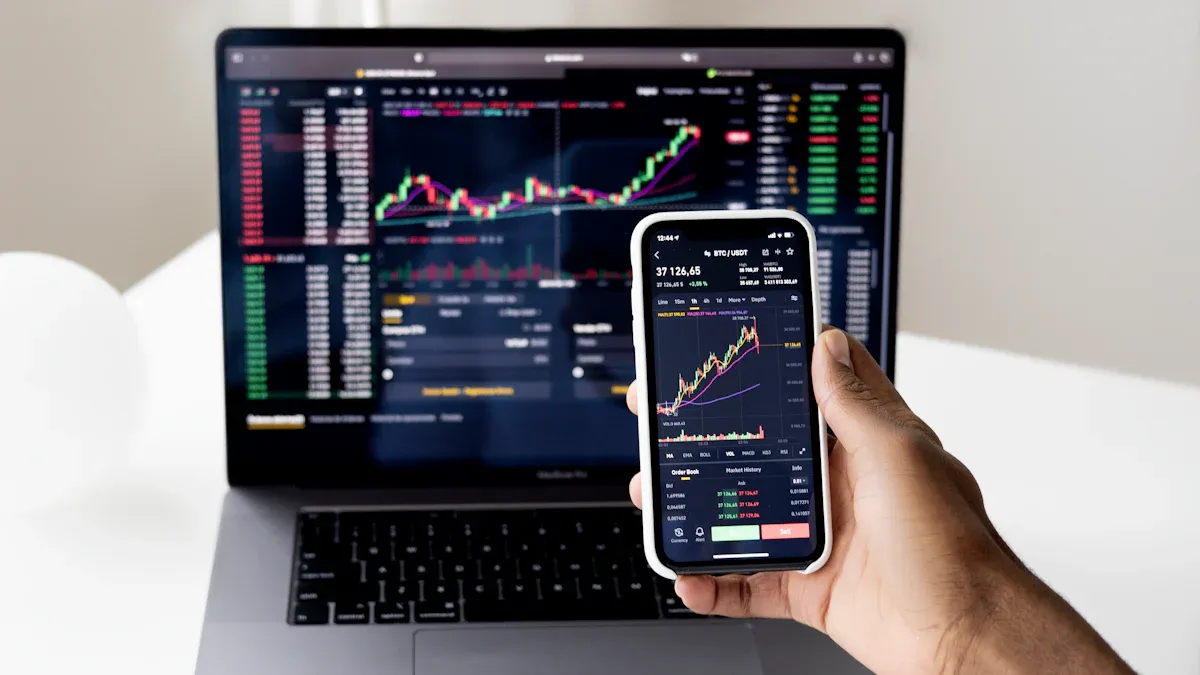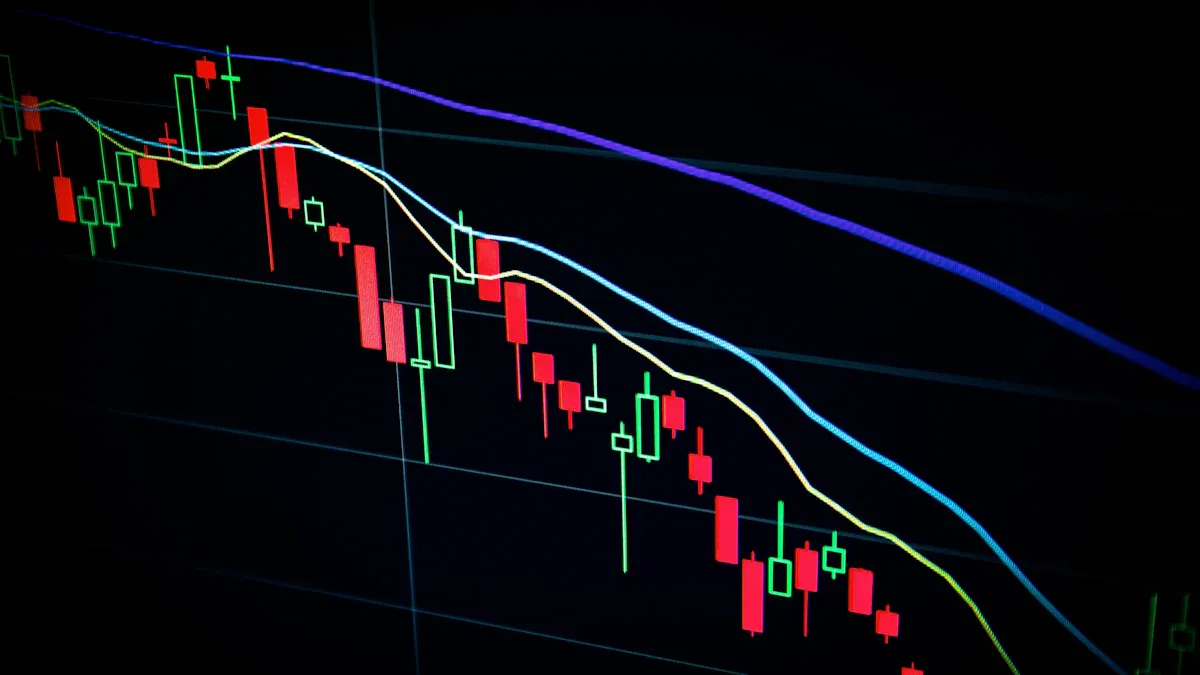- EasyCard
- Trade
- Help
- Announcement
- Academy
- SWIFT Code
- Iban Number
- Referral
- Customer Service
- Blog
- Creator
How to Identify and Respond to Sudden Risks in Hong Kong Stock Trading?

Image Source: pexels
When investing in the Hong Kong stock market, you often encounter significant volatility and unique rules. Hong Kong stocks are highly sensitive to non-economic events, such as U.S.-China tensions or the COVID-19 pandemic, which can amplify risks. Refer to the table below to understand the historical volatility and major risk events in the Hong Kong stock market:
| Statistical Content | Specific Data and Description |
|---|---|
| Historical Volatility | The Hang Seng Composite Index showed significant volatility from 2001 to 2018, with prominent cyclical characteristics. |
| Major Risk Events | The dot-com bubble, 9/11 attacks, and the subprime crisis had profound impacts. |
| Risk Types | No price limits, weak liquidity, and significant impacts from policy and macroeconomic events. |
You need to prioritize risk management by establishing early warning mechanisms and contingency strategies to enhance your response capabilities.
Key Points
- The Hong Kong stock market is highly volatile with no price limits, so you should set stop-loss points and control positions to avoid significant losses during investment.
- Pay attention to policy and regulatory changes, adjust investment strategies promptly, and mitigate risks arising from rule changes.
- Use information monitoring and data analysis tools to detect price and trading volume anomalies in real-time, enabling early risk warnings.
- Reduce risks from single stocks or market fluctuations through diversified investments and derivative hedging.
- Maintain rational investing and strict discipline, avoid emotional trading, and adhere to steady long-term investment strategies.
Types of Sudden Risks in Hong Kong Stocks

Image Source: unsplash
Market Volatility Risk
When trading in the Hong Kong stock market, you will notice that its volatility is much higher than that of Chinese A-shares. Hong Kong stocks operate under a T+0 trading mechanism, allowing you to buy and sell on the same day, which makes trading flexible but also prone to frequent trading. Hong Kong stocks have no price limits, so stock prices may surge or plummet significantly within a single day, sometimes doubling or halving in extreme cases. You should also note that exchange rate fluctuations between the Hong Kong dollar and the Chinese yuan can affect your investment returns. The Hong Kong market is heavily influenced by global economic conditions, political situations, and international trade relations, and shifts in investor sentiment can exacerbate market volatility. Some small-cap stocks have lower liquidity, leading to larger bid-ask spreads, which increases trading difficulty.
Market volatility in Hong Kong stocks is driven not only by rational analysis but also by investor sentiment. Studies show that negative sentiment can contribute up to 24% of the influence in bearish markets, easily triggering sharp fluctuations.
Policy and Regulatory Risk
When investing in Hong Kong stocks, you must pay attention to policy and regulatory changes. In recent years, the U.S. Foreign Company Accountability Act has put many Chinese concept stocks at risk of delisting, prompting their return to the Hong Kong market. The Hong Kong Stock Exchange has continuously adjusted listing rules, such as allowing unprofitable biotech companies to list and introducing a dual-class share structure. While these changes bring new opportunities, they also pose compliance challenges, such as issues with audit working papers and data security. The Hong Kong market adopts an approval-based system with stringent disclosure requirements, and regulations differ from those in China and the U.S. You need to closely monitor policy developments and adjust investment strategies promptly.
- U.S. regulatory changes affect the listing choices of Chinese concept stocks.
- The Hong Kong Stock Exchange optimizes IPO settlement processes to improve market efficiency.
- Cross-border regulatory differences create compliance challenges.
Delisting and Suspension Risk
The reasons for delisting and suspension of Hong Kong stocks are varied. Deterioration in a company’s financial condition, prolonged suspension (e.g., over 3 months), privatization by major shareholders, or listing transfers can lead to delisting. Suspensions often occur due to sensitive company announcements, acquisition negotiations, or abnormal market fluctuations. When stocks are suspended, you may be unable to trade them promptly, and inadequate information disclosure can make it difficult to stay updated on company developments. Delisting and suspensions reduce stock liquidity, increase investment risks, and may even lead to asset losses.
Hong Kong Stock Connect Quota and System Differences
When investing through Hong Kong Stock Connect, you will encounter quota restrictions. The daily buying quota is limited, and once exhausted, you cannot continue purchasing, especially during the closing auction session when quota changes require close attention. Hong Kong stocks use a tiered settlement system, which carries settlement risks, such as delays in extreme weather conditions in Hong Kong. You should also note differences in trading hours, odd-lot handling, and voting rights. Investing via Hong Kong Stock Connect involves exchange rate fluctuations and different tax systems, which may affect your fund allocation and investment costs. For example, trading Hong Kong Stock Connect stocks requires paying taxes per Hong Kong regulations, and transaction and settlement fees are settled in USD, so you need to monitor the impact of exchange rate changes.
Tip: Hong Kong stock quote colors are the opposite of Chinese A-shares—green for price increases and red for decreases—so be cautious during trading to avoid misjudging market trends.
Risk Management and Identification Methods
Information Monitoring and Early Warning
When investing in the Hong Kong stock market, information monitoring and early warning mechanisms are critical. The market’s high volatility means sudden risks often stem from major news, policy changes, or company announcements. You can detect risks promptly through the following methods:
- Monitor the Hong Kong Stock Exchange website, listed company announcements, and mainstream financial news to stay updated on market dynamics.
- Use automated monitoring systems to set alert thresholds for price and trading volume. When a stock’s price or volume shows abnormal fluctuations in a short period, the system will automatically issue alerts.
- Use API interfaces to capture real-time data for multiple stocks, combined with asynchronous programming to achieve efficient monitoring.
- After major news events or company announcements, promptly analyze their impact on related stocks and respond quickly.
- Regularly test and maintain monitoring systems to ensure stable and reliable early warning mechanisms.
Stock anomalies typically manifest as abnormal fluctuations in price or trading volume. By monitoring these indicators in real-time, you can identify potential risks early and prepare for risk management.
Data Analysis Tools
When identifying risks in the Hong Kong stock market, data analysis tools are indispensable. Modern fintech provides you with various efficient tools:
- Machine learning-driven risk prediction models can analyze large volumes of historical data to predict market volatility and issue early risk signals.
- Real-time risk monitoring systems help you track market risk changes at all times, ensuring fund safety.
- Automated trading risk control measures adjust positions automatically based on market fluctuations, reducing human error risks.
- Big data analysis and robo-advisor technologies deeply analyze historical and real-time market data, enhancing risk identification and management capabilities.
You can combine these tools to dynamically adjust your portfolio and improve risk management. For example, in 2023, a tech stock fell over 30% in a single day due to disappointing earnings. If you had set price alerts in advance, you could have stopped losses in time, avoiding greater damage.
Combining Technical and Fundamental Analysis
When managing risks in the Hong Kong stock market, relying solely on one method is insufficient. Combining technical and fundamental analysis allows you to identify and respond to risks more comprehensively.
- Technical analysis helps you detect abnormal price and volume fluctuations, capturing market anomaly signals promptly.
- Fundamental analysis enables you to understand a company’s financial health, industry prospects, and policy environment, assessing its long-term value and potential risks.
- You can establish risk warning mechanisms by integrating VAR models, risk matrices, and dynamic reports to quantify and manage market risks hierarchically.
- Regularly collect and process relevant data to identify risk patterns and market trends, forming scientific risk prediction and response strategies.
In practice, you can create a risk matrix table in Excel to assist in hierarchically managing different types of risks. Regularly summarize analysis results to continuously optimize your risk management system.
Only by continuously refining information monitoring, data analysis, and multidimensional risk identification methods can you better protect your assets and achieve steady investing in the Hong Kong stock market.
Risk Management Strategies
Stop-Loss and Position Control
When investing in the Hong Kong stock market, stop-loss and position control are the most fundamental and effective risk management tools. The market’s high volatility and lack of price limits make significant single-day fluctuations common. You can adopt various stop-loss methods:
- Use the ATR (Average True Range) indicator, which reflects a stock’s volatility range. You can set reasonable stop-loss points based on ATR to avoid premature stop-outs due to short-term fluctuations.
- Set stop-loss based on price action. For example, in an uptrend, place the stop-loss below the previous low; in a downtrend, place it above the previous high.
- In range trading, set stop-losses outside the range’s opposite extreme. For buying low, place the stop-loss below the extreme low; for selling high, place it above the extreme high.
You also need to calculate positions scientifically to avoid liquidation due to over-leveraging. Below is a commonly used position management table:
| Method Category | Specific Details |
|---|---|
| Position Calculation Formula | Position = (Total Capital × Acceptable Loss Ratio) ÷ (Per-Point Capital Change × Stop-Loss Points) |
| Parameter Explanation | Total Capital: Total account funds; Acceptable Loss Ratio: Recommended not to exceed 1%-2%; Per-Point Capital Change: Varies by trading product; Stop-Loss Points: Set based on trading system |
| Single Trade Loss Control | Recommend controlling single trade losses within 1%-2% of total capital |
| Overall Account Risk Control | Recommend monthly drawdown not exceeding 10%; if exceeded, pause live trading or switch to demo trading |
| Risk Management Levels | From no risk management to strict stop-loss and position control, avoiding blind position increases leading to liquidation |
You can refer to the experience of renowned traders, keeping single trade losses within 1%-2% of total capital. This ensures that even consecutive losses won’t devastate your account. You can also set a maximum monthly drawdown, pausing live trading if it exceeds 10% and switching to demo trading to prevent emotional breakdowns.
Tip: In practice, use Excel or trading software to automatically calculate positions and stop-loss points to improve execution efficiency.
Diversified Investment
When investing in the Hong Kong stock market, diversified investment can effectively reduce risks from single stocks or sectors. Diversification goes beyond buying multiple stocks; it involves diversifying across industries, asset classes, and regions. You can choose stocks of different market caps and sectors, and allocate to structured products, ETFs, bonds, and other assets. This ensures your portfolio remains stable even if one sector experiences significant volatility.
For investors with lower risk tolerance, you can choose low-volatility products like fixed-income plus funds or volatility-anchored funds. These products often use AI-driven dynamic rebalancing and risk budgeting models to control equity exposure and reduce drawdown risks. If you have higher risk tolerance, consider multi-asset FOFs, cross-border asset allocation FOFs, or multi-asset ETFs to diversify single-market risks and improve the portfolio’s risk-reward ratio through multi-asset and cross-border allocations.
You can also explore asset allocation products, which offer professional strategies to provide one-stop solutions for investors with varying risk preferences, meeting diverse needs.
Derivative Hedging
When facing extreme market conditions in the Hong Kong stock market, you can use derivatives for hedging to enhance risk management. Common hedging tools include:
- Index futures: You can use Hang Seng Index futures to hedge your Hong Kong stock portfolio, reducing systemic risks.
- Index options: You can buy put options to lock in downside risks or use call options to capture upside opportunities.
- Commodity futures: You can use commodity futures for calendar or cross-period arbitrage to meet diverse hedging needs.
- Over-the-counter options: Although some markets have regulatory restrictions, OTC options remain an important hedging tool.
- Gold ETFs, index-enhanced products, and other structured products: You can further diversify risks by allocating to these products.
Institutional investors often use market-neutral and index-enhanced strategies to achieve risk hedging and return optimization through derivatives. You can adopt these methods, selecting appropriate hedging tools based on your needs. For example, in extreme market conditions, using index futures to build absolute return strategies can effectively mitigate systemic risks.
Note: When using derivatives, understand their structure and risk characteristics to avoid amplified losses due to excessive leverage.
Emotion and Discipline
When investing in the Hong Kong stock market, emotion and discipline are equally important. Emotional investing can lead to irrational decisions; over-optimism may cause you to overlook risks, while excessive pessimism may make you miss opportunities. You need to establish strict trading discipline:
- Adhere to the buy-low, sell-high principle, avoiding chasing highs or panic-selling lows.
- Control trading frequency, avoid checking your account frequently, and reduce emotional interference.
- Develop an automated investment plan and execute it consistently, avoiding impromptu strategy changes.
- Use experience-based rules and environmental controls to enhance self-discipline for long-term rational investing.
Quantitative investing is a method worth adopting. You can use computers to analyze data, reducing emotional biases and improving risk management discipline. Quantitative funds cover the entire market, evaluating stocks from multiple perspectives to enhance risk control and mitigate market volatility.
You can also learn from international markets by signing risk disclosure statements to clarify investment risks and strengthen risk management awareness. Before investing, thoroughly understand market rules and product characteristics to align knowledge with action.
Investor education and a long-term investment philosophy are crucial. Only by adhering to rational investing and compliant operations can you progress steadily in the Hong Kong stock market.
Tools and Resources

Image Source: pexels
Risk Monitoring Platforms
When investing in the Hong Kong stock market, choosing the right risk monitoring platform is critical. Many platforms offer real-time data, risk alerts, and portfolio management features. For example, the risk monitoring solution launched by Fourth Paradigm and Jiumao Technology supports intelligent risk alerts, portfolio management, and compliant custody. You can use these platforms to dynamically monitor USD, RMB, and HKD-linked asset pools, enhancing risk identification capabilities. The table below outlines the core functions of mainstream risk monitoring platforms:
| Function Module | Description |
|---|---|
| Data Coverage | Covers financial data for Hong Kong stocks and over 40 global exchanges. |
| Portfolio Management | Real-time monitoring of portfolio profits/losses and risk metrics. |
| Risk Analysis | Graphical display of portfolio risk status, supporting alerts and decision-making. |
| News and Reports | Provides 24/7 financial news and in-depth research reports. |
| Technical Support | Offers Excel plugins and APIs for easy data access and model building. |
| Mobile Support | Supports multi-platform monitoring and decision-making on the go. |
Information Acquisition Channels
You need to access authoritative information promptly to manage risks effectively. You can obtain the latest announcements and risk alerts for the Hong Kong stock market through the following channels:
- Visit the Hong Kong Stock Exchange’s “HKEXnews” website to review company annual reports and announcements.
- Follow the “Hong Kong Stock Connect” WeChat public account for updates on eligible stocks and announcements.
- Refer to announcements from the Shanghai and Shenzhen Stock Exchanges.
- Monitor risk alerts published on official WeChat accounts and exchange websites.
- Use investor education platforms like Northeast Securities to access investor protection and risk warning information.
Be cautious of risks to fund security and data breaches from non-compliant platforms, and choose regulated channels to protect your interests.
Investment Communities and Data Analysis
You can leverage investment communities and data analysis platforms to enhance risk management capabilities. Data analysis platforms analyze fund flows and event-driven signals, helping you grasp market dynamics and risk points. Event-driven research reveals market patterns, assisting you in optimizing buy/sell timing, especially for low-coverage stocks. Investment communities facilitate information sharing through social trading and strategy copying, helping you build risk consensus. Machine learning technologies provide personalized stock selection advice and risk alerts, automatically identifying market hotspots to enhance risk perception and response capabilities. You can also use AI tools to process information efficiently, improving decision quality and risk screening efficiency.
In the Hong Kong stock market, you will encounter various sudden risks, such as pump-and-dump schemes, black swan events, and short-seller reports. You can improve risk management by investing through Hong Kong Stock Connect, avoiding low-price placement stocks, and tracking corporate fundamentals over the long term. During asset allocation, bonds and gold often serve as safe-haven assets, but gold’s safe-haven effect is primarily evident in the early stages of events. You need to dynamically adjust strategies, reasonably control tail-risk asset positions, and avoid risk concentration. Continuous learning and flexible strategy adjustments can help you protect yourself in complex markets. You must also adhere to rational investing and compliant operations, following market rules to progress steadily in the Hong Kong stock market.
FAQ
How Does the T+0 Trading Mechanism Affect You?
The T+0 mechanism allows you to buy and sell on the same day. You can adjust positions flexibly, but frequent trading may increase transaction costs and risks.
With No Price Limits in Hong Kong Stocks, How Do You Control Losses?
You can set stop-loss points to limit losses promptly. You can also diversify investments to avoid significant losses from single stock volatility.
Can You Buy When Hong Kong Stock Connect Quotas Are Exhausted?
When quotas are exhausted, you cannot continue buying Hong Kong Stock Connect stocks. You need to monitor real-time quota changes and plan trading times accordingly.
How Can You Access Authoritative Hong Kong Stock Information?
You can visit the Hong Kong Stock Exchange website, HKEXnews platform, or use Bloomberg and Reuters data services to access the latest announcements and market dynamics.
What Are the Main Fees Involved in Hong Kong Stock Investing?
You need to pay trading commissions, stamp duties, and settlement fees. All fees are settled in USD, so monitor exchange rate changes affecting costs.
This article provides a comprehensive and in-depth analysis of sudden risks in Hong Kong stock trading, covering market volatility, policy regulation, and delisting risks. The article not only helps investors identify these risks but also offers specific response strategies, such as setting stop-losses, managing position sizes, diversifying investments, and using derivatives for hedging. This provides a valuable practical guide for Hong Kong stock investors.
However, despite the detailed discussion of the inherent risks of Hong Kong stock trading, a core pain point for many Chinese investors lies in the flow of cross-border funds. Traditional funding methods, such as bank wire transfers, are not only complex and time-consuming but also come with high fees and opaque exchange rate spreads. These issues directly impact investment returns and increase transaction costs.
BiyaPay was created to solve these cross-border financial pain points. We offer a smoother, more cost-effective investment channel. We support the conversion between various fiat and digital currencies, allowing you to easily manage global assets, and provide a real-time exchange rate query feature to ensure you always get the best rates. What’s more, our remittance fees are as low as 0.5% with same-day delivery, significantly cutting down your transaction costs and time. Now, you don’t need a complex overseas account to invest in both U.S. and Hong Kong stocks on one platform. Say goodbye to the hassle of cross-border payments and start your efficient financial journey. Register with BiyaPay today to make fund management as smooth as trading.
*This article is provided for general information purposes and does not constitute legal, tax or other professional advice from BiyaPay or its subsidiaries and its affiliates, and it is not intended as a substitute for obtaining advice from a financial advisor or any other professional.
We make no representations, warranties or warranties, express or implied, as to the accuracy, completeness or timeliness of the contents of this publication.




Contact Us
Company and Team
BiyaPay Products
Customer Services
is a broker-dealer registered with the U.S. Securities and Exchange Commission (SEC) (No.: 802-127417), member of the Financial Industry Regulatory Authority (FINRA) (CRD: 325027), member of the Securities Investor Protection Corporation (SIPC), and regulated by FINRA and SEC.
registered with the US Financial Crimes Enforcement Network (FinCEN), as a Money Services Business (MSB), registration number: 31000218637349, and regulated by FinCEN.
registered as Financial Service Provider (FSP number: FSP1007221) in New Zealand, and is a member of the Financial Dispute Resolution Scheme, a New Zealand independent dispute resolution service provider.



















